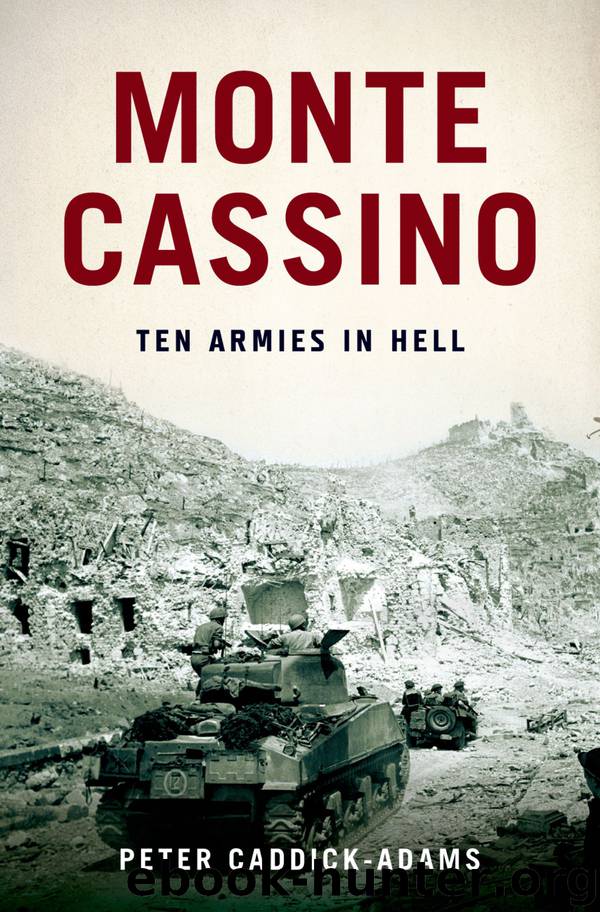Monte Cassino: Ten Armies in Hell by Caddick-Adams Peter

Author:Caddick-Adams, Peter
Language: eng
Format: epub
Publisher: Oxford University Press, USA
Published: 2013-05-20T16:00:00+00:00
The tank attack along the Cavendish Road, Freyberg’s last major attempt to seize the initiative, cost the 20th NZ Armoured Regiment eleven casualties and sixteen tanks disabled. The month as a whole was far deadlier with fifty-four killed, wounded or captured, while most of the unit’s vehicles at some stage were disabled by enemy fire, throwing tracks, getting bogged down or tipping into ditches. Scenting a good news story for the German propaganda machine, a German cine cameraman happened to be on Point 593 that day and recorded footage of the tank attack on Albaneta, which was shown in the weekly newsreel Die Deutsche Wochenschau, the camera lingering on crippled Allied tanks amid the abbey’s ruins.
After nearly a week in Cassino town, the main aim of the attack – to gain control of the Route 6, the Via Casilina, and thus storm the Liri valley – had not been achieved. The third battle had, in fact, dissolved into a muddle of six New Zealand battalions, plus armour, trying to overcome the remaining German centres of resistance based in several big stone buildings that had somehow survived the bombing and shelling. In their reports, most Allied newspapers reached out for the language they had used a year earlier to describe the Stalingrad campaign, perhaps hoping that Cassino, too, would prove the graveyard of another German army. On 20 March, The Times told its readers: ‘By last evening the New Zealanders, fighting their way through the rubble of demolished houses, had quenched German resistance in the town except for two strong-points.’ Their ‘progress across the wreck of the town has not been easy. The Germans had prepared deep shelters in the hillside caves, whence they emerged after the bombardment and resisted stubbornly. The movement of our supporting tanks was made difficult by the immense mounds of rubble caused by our bombing.’
Freyberg, to further protect his forces, now ordered a permanent smoke screen over Cassino by day, which all found detrimental. New Zealand infantry complained the smoke stung their eyes and throats, while the Germans at times needed respirators, and the Allied field artillery batteries, firing up to 10,000 rounds per day, soon found they were dealing with worn barrels and blistered hands. Sometimes, wind blew the smoke backwards, filling gun positions with the stuff and suffocating gunners, who were obliged to don gasmasks, and several were medically evacuated to be treated for the after-effects of their own smoke.
After a conference with his divisional commanders that same day, Freyberg agreed to refresh the attack by inserting the 21st NZ Battalion shortly after midnight to attack the Continental Hotel area, but on 21 March a whole platoon of its D Company were spotted by German troops in the hotel, surrounded and taken prisoner. A German cameraman was on hand to film the mass capture. In the images, the Kiwi prisoners appear understandably very nervous: they had just been searched and several were found to be carrying Fallschirmjäger jump badges, taken from dead or captured paratroops.
Download
This site does not store any files on its server. We only index and link to content provided by other sites. Please contact the content providers to delete copyright contents if any and email us, we'll remove relevant links or contents immediately.
| Belgium | France |
| Germany | Great Britain |
| Greenland | Italy |
| Netherlands | Romania |
| Scandinavia |
Room 212 by Kate Stewart(5071)
The Crown by Robert Lacey(4761)
Endurance: Shackleton's Incredible Voyage by Alfred Lansing(4719)
The Iron Duke by The Iron Duke(4320)
The Rape of Nanking by Iris Chang(4167)
Joan of Arc by Mary Gordon(4054)
Killing England by Bill O'Reilly(3969)
Say Nothing by Patrick Radden Keefe(3937)
I'll Give You the Sun by Jandy Nelson(3394)
Shadow of Night by Deborah Harkness(3326)
Hitler's Monsters by Eric Kurlander(3291)
Mary, Queen of Scots, and the Murder of Lord Darnley by Alison Weir(3171)
Blood and Sand by Alex Von Tunzelmann(3165)
Eleanor & Park by Rainbow Rowell(3112)
Darkest Hour by Anthony McCarten(3096)
Margaret Thatcher: The Autobiography by Thatcher Margaret(3046)
Book of Life by Deborah Harkness(2893)
Red Famine: Stalin's War on Ukraine by Anne Applebaum(2890)
The One Memory of Flora Banks by Emily Barr(2829)
